Business Research: Social Network Advantages and Disadvantages
VerifiedAdded on 2020/04/01
|17
|2112
|63
Report
AI Summary
This research report examines the impact of social networks on business performance, exploring both the benefits and challenges associated with their use. The report begins with an introduction to the evolving business environment and the increasing adoption of social networking platforms for marketing and communication purposes. It then outlines the project objectives, scope, and a comprehensive literature review that highlights various authors' perspectives on social media's role in business. The research addresses key questions regarding the trends, advantages, and disadvantages of using social networks, along with the factors influencing business decisions in this area. The report details the research design, methodology, including qualitative research methods, data collection strategies using primary and secondary sources, and data analysis techniques. It also considers research limitations and ethical aspects. The conclusion summarizes the findings, emphasizing the growing importance of social networks in business and the knowledge gained regarding their advantages and disadvantages, supported by references and an appendix.
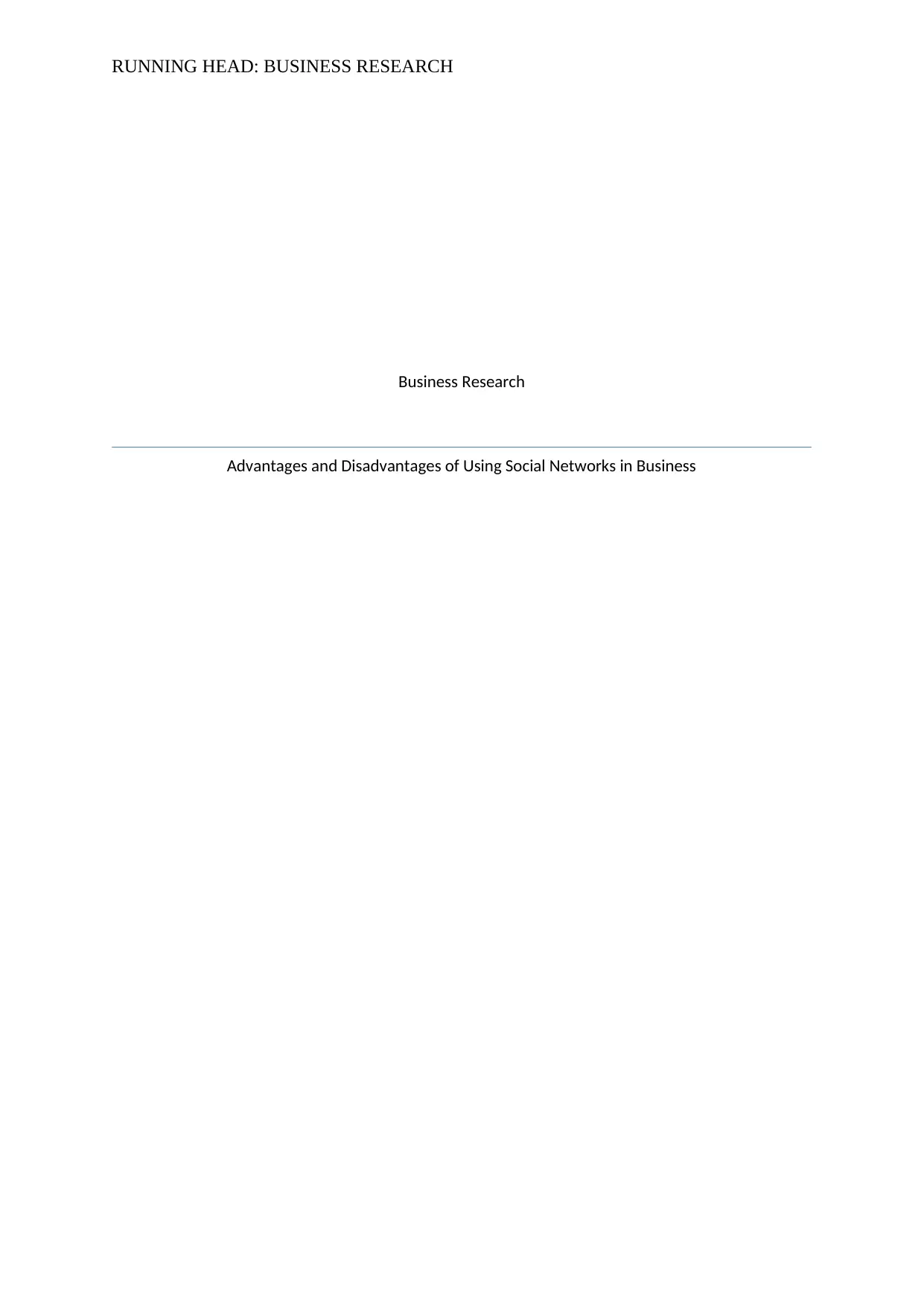
RUNNING HEAD: BUSINESS RESEARCH
Business Research
Advantages and Disadvantages of Using Social Networks in Business
Business Research
Advantages and Disadvantages of Using Social Networks in Business
Paraphrase This Document
Need a fresh take? Get an instant paraphrase of this document with our AI Paraphraser
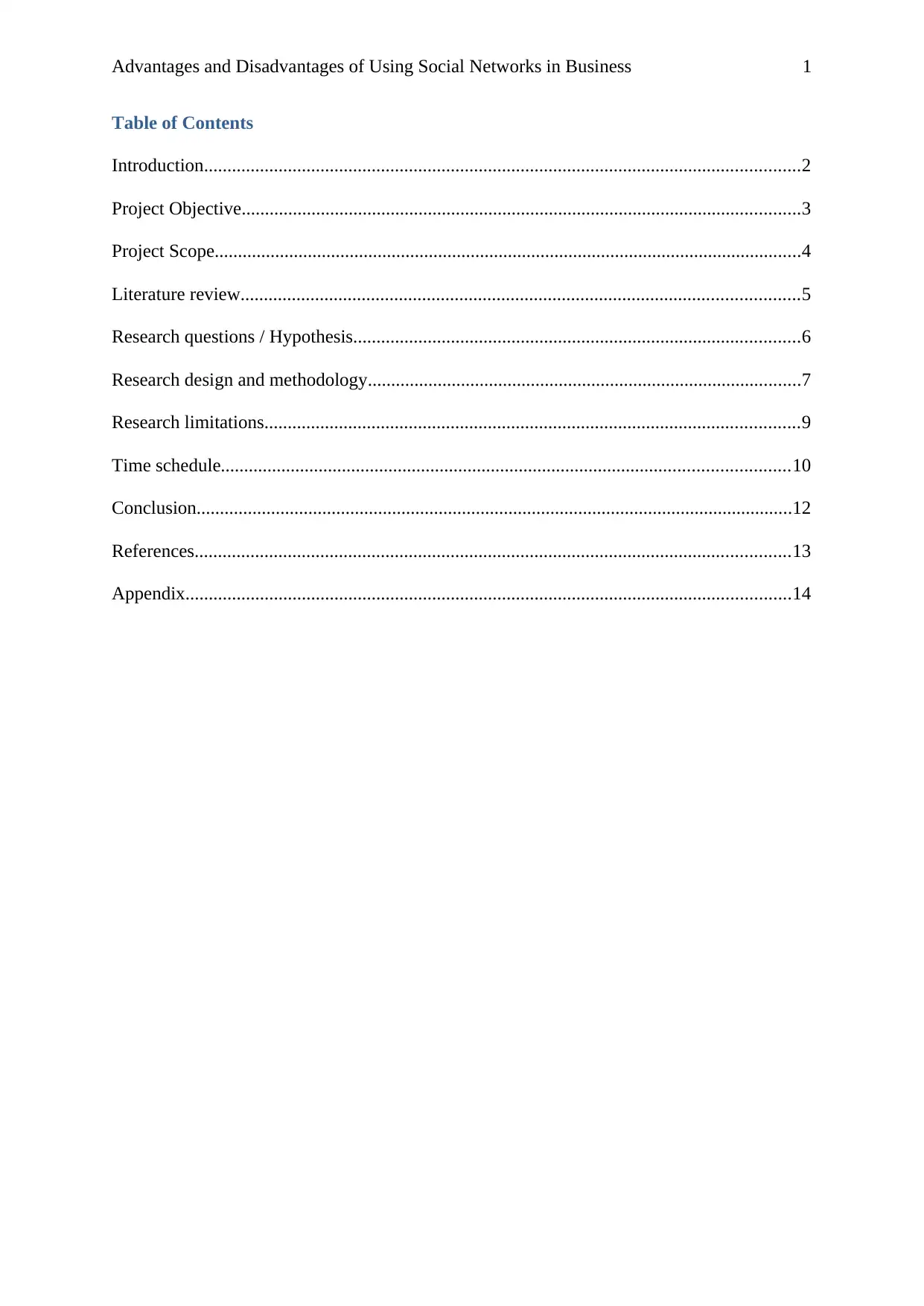
Advantages and Disadvantages of Using Social Networks in Business 1
Table of Contents
Introduction................................................................................................................................2
Project Objective........................................................................................................................3
Project Scope..............................................................................................................................4
Literature review........................................................................................................................5
Research questions / Hypothesis................................................................................................6
Research design and methodology.............................................................................................7
Research limitations...................................................................................................................9
Time schedule..........................................................................................................................10
Conclusion................................................................................................................................12
References................................................................................................................................13
Appendix..................................................................................................................................14
Table of Contents
Introduction................................................................................................................................2
Project Objective........................................................................................................................3
Project Scope..............................................................................................................................4
Literature review........................................................................................................................5
Research questions / Hypothesis................................................................................................6
Research design and methodology.............................................................................................7
Research limitations...................................................................................................................9
Time schedule..........................................................................................................................10
Conclusion................................................................................................................................12
References................................................................................................................................13
Appendix..................................................................................................................................14
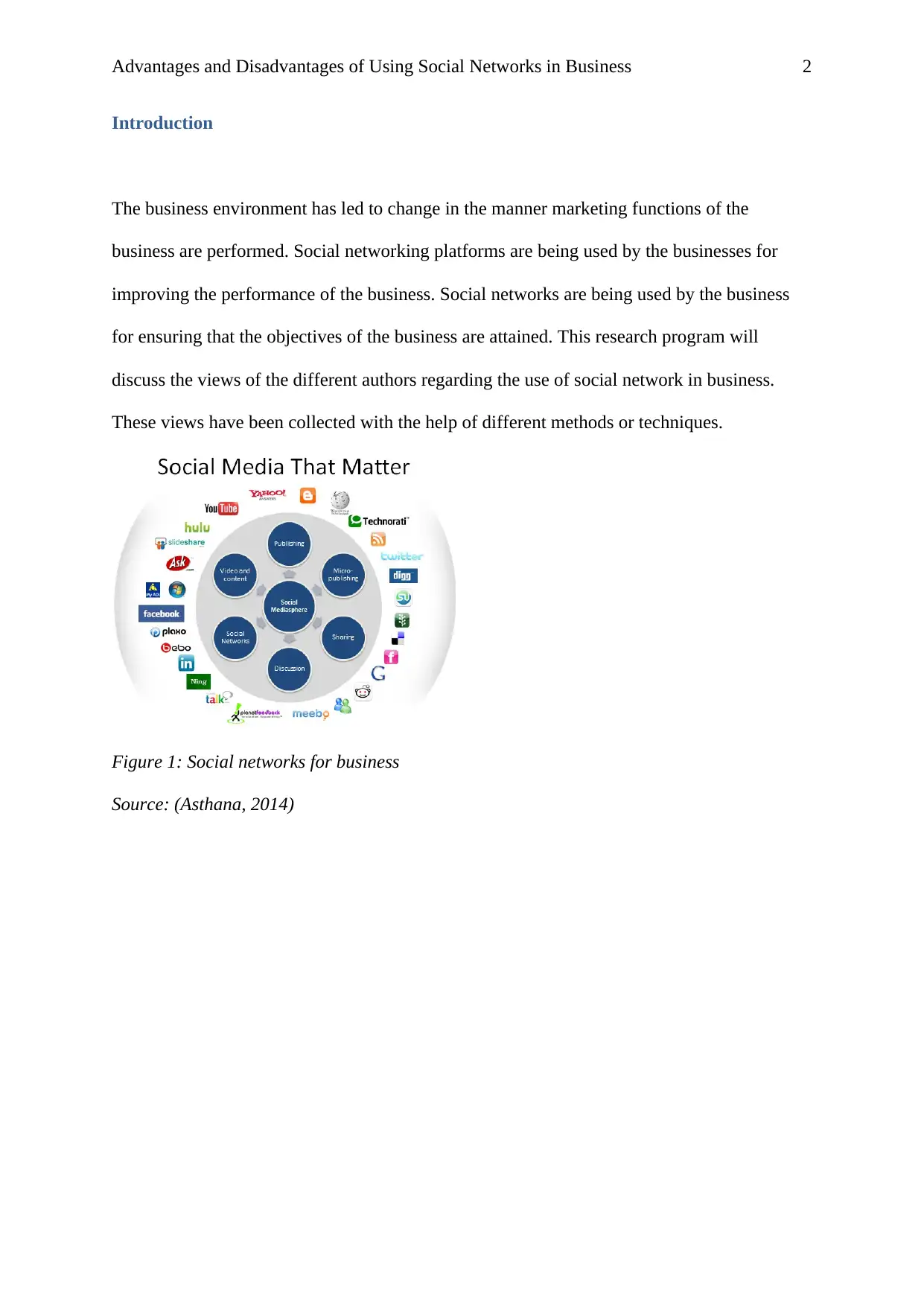
Advantages and Disadvantages of Using Social Networks in Business 2
Introduction
The business environment has led to change in the manner marketing functions of the
business are performed. Social networking platforms are being used by the businesses for
improving the performance of the business. Social networks are being used by the business
for ensuring that the objectives of the business are attained. This research program will
discuss the views of the different authors regarding the use of social network in business.
These views have been collected with the help of different methods or techniques.
Figure 1: Social networks for business
Source: (Asthana, 2014)
Introduction
The business environment has led to change in the manner marketing functions of the
business are performed. Social networking platforms are being used by the businesses for
improving the performance of the business. Social networks are being used by the business
for ensuring that the objectives of the business are attained. This research program will
discuss the views of the different authors regarding the use of social network in business.
These views have been collected with the help of different methods or techniques.
Figure 1: Social networks for business
Source: (Asthana, 2014)
⊘ This is a preview!⊘
Do you want full access?
Subscribe today to unlock all pages.

Trusted by 1+ million students worldwide

Advantages and Disadvantages of Using Social Networks in Business 3
Project Objective
This research has discussed the importance of social networks for business. This research has
covered various aspects which affect the decision taken by the business regarding the use of
the social network for business. The objective behind conducting this research is to gather
knowledge of these aspects of social networking.
Project Objective
This research has discussed the importance of social networks for business. This research has
covered various aspects which affect the decision taken by the business regarding the use of
the social network for business. The objective behind conducting this research is to gather
knowledge of these aspects of social networking.
Paraphrase This Document
Need a fresh take? Get an instant paraphrase of this document with our AI Paraphraser

Advantages and Disadvantages of Using Social Networks in Business 4
Project Scope
The scope defines the aspects which will be covered in the research program. Areas covered
in this research program include explaining the trend of use of social networks for business. It
will also discuss the benefits and challenges faced by the business due to the use of social
networking platforms for businesses.
Project Scope
The scope defines the aspects which will be covered in the research program. Areas covered
in this research program include explaining the trend of use of social networks for business. It
will also discuss the benefits and challenges faced by the business due to the use of social
networking platforms for businesses.
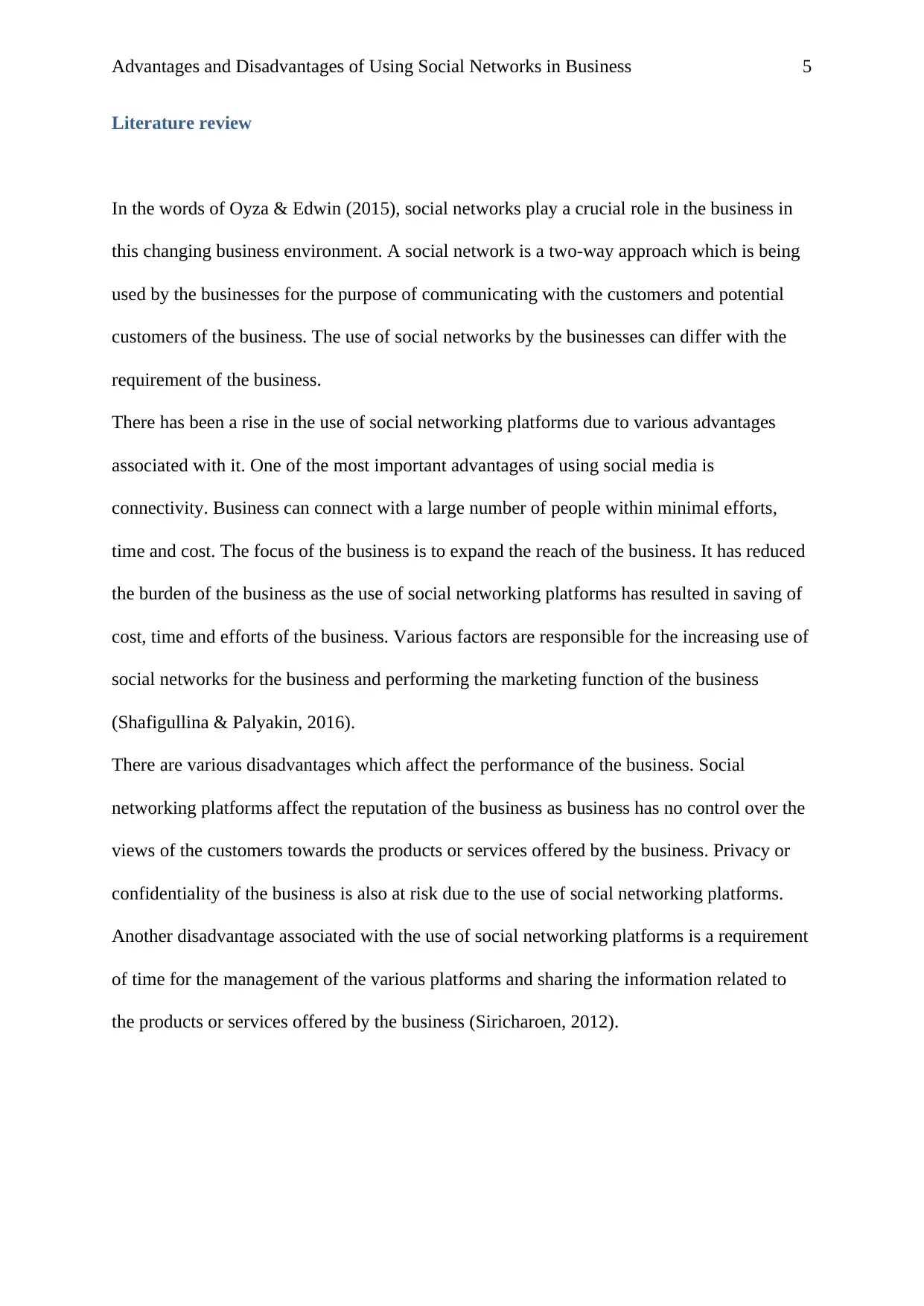
Advantages and Disadvantages of Using Social Networks in Business 5
Literature review
In the words of Oyza & Edwin (2015), social networks play a crucial role in the business in
this changing business environment. A social network is a two-way approach which is being
used by the businesses for the purpose of communicating with the customers and potential
customers of the business. The use of social networks by the businesses can differ with the
requirement of the business.
There has been a rise in the use of social networking platforms due to various advantages
associated with it. One of the most important advantages of using social media is
connectivity. Business can connect with a large number of people within minimal efforts,
time and cost. The focus of the business is to expand the reach of the business. It has reduced
the burden of the business as the use of social networking platforms has resulted in saving of
cost, time and efforts of the business. Various factors are responsible for the increasing use of
social networks for the business and performing the marketing function of the business
(Shafigullina & Palyakin, 2016).
There are various disadvantages which affect the performance of the business. Social
networking platforms affect the reputation of the business as business has no control over the
views of the customers towards the products or services offered by the business. Privacy or
confidentiality of the business is also at risk due to the use of social networking platforms.
Another disadvantage associated with the use of social networking platforms is a requirement
of time for the management of the various platforms and sharing the information related to
the products or services offered by the business (Siricharoen, 2012).
Literature review
In the words of Oyza & Edwin (2015), social networks play a crucial role in the business in
this changing business environment. A social network is a two-way approach which is being
used by the businesses for the purpose of communicating with the customers and potential
customers of the business. The use of social networks by the businesses can differ with the
requirement of the business.
There has been a rise in the use of social networking platforms due to various advantages
associated with it. One of the most important advantages of using social media is
connectivity. Business can connect with a large number of people within minimal efforts,
time and cost. The focus of the business is to expand the reach of the business. It has reduced
the burden of the business as the use of social networking platforms has resulted in saving of
cost, time and efforts of the business. Various factors are responsible for the increasing use of
social networks for the business and performing the marketing function of the business
(Shafigullina & Palyakin, 2016).
There are various disadvantages which affect the performance of the business. Social
networking platforms affect the reputation of the business as business has no control over the
views of the customers towards the products or services offered by the business. Privacy or
confidentiality of the business is also at risk due to the use of social networking platforms.
Another disadvantage associated with the use of social networking platforms is a requirement
of time for the management of the various platforms and sharing the information related to
the products or services offered by the business (Siricharoen, 2012).
⊘ This is a preview!⊘
Do you want full access?
Subscribe today to unlock all pages.

Trusted by 1+ million students worldwide

Advantages and Disadvantages of Using Social Networks in Business 6
Research questions / Hypothesis
Primary research question
The research question for this research program is stated below:
What are the benefits and challenges associated with the use of the social network for
business?
Secondary research questions
Secondary questions are listed below:
What is the trend of use of social network in business in this fast-changing
environment?
Which aspects related to the social networking platforms are affecting the decision of
business for use of these platforms?
Hypothesis
The role of the social network has increased for the business due to the changing
business environment and changing technology.
Social networks are creating harm to the confidentiality and privacy of the business.
Research questions / Hypothesis
Primary research question
The research question for this research program is stated below:
What are the benefits and challenges associated with the use of the social network for
business?
Secondary research questions
Secondary questions are listed below:
What is the trend of use of social network in business in this fast-changing
environment?
Which aspects related to the social networking platforms are affecting the decision of
business for use of these platforms?
Hypothesis
The role of the social network has increased for the business due to the changing
business environment and changing technology.
Social networks are creating harm to the confidentiality and privacy of the business.
Paraphrase This Document
Need a fresh take? Get an instant paraphrase of this document with our AI Paraphraser
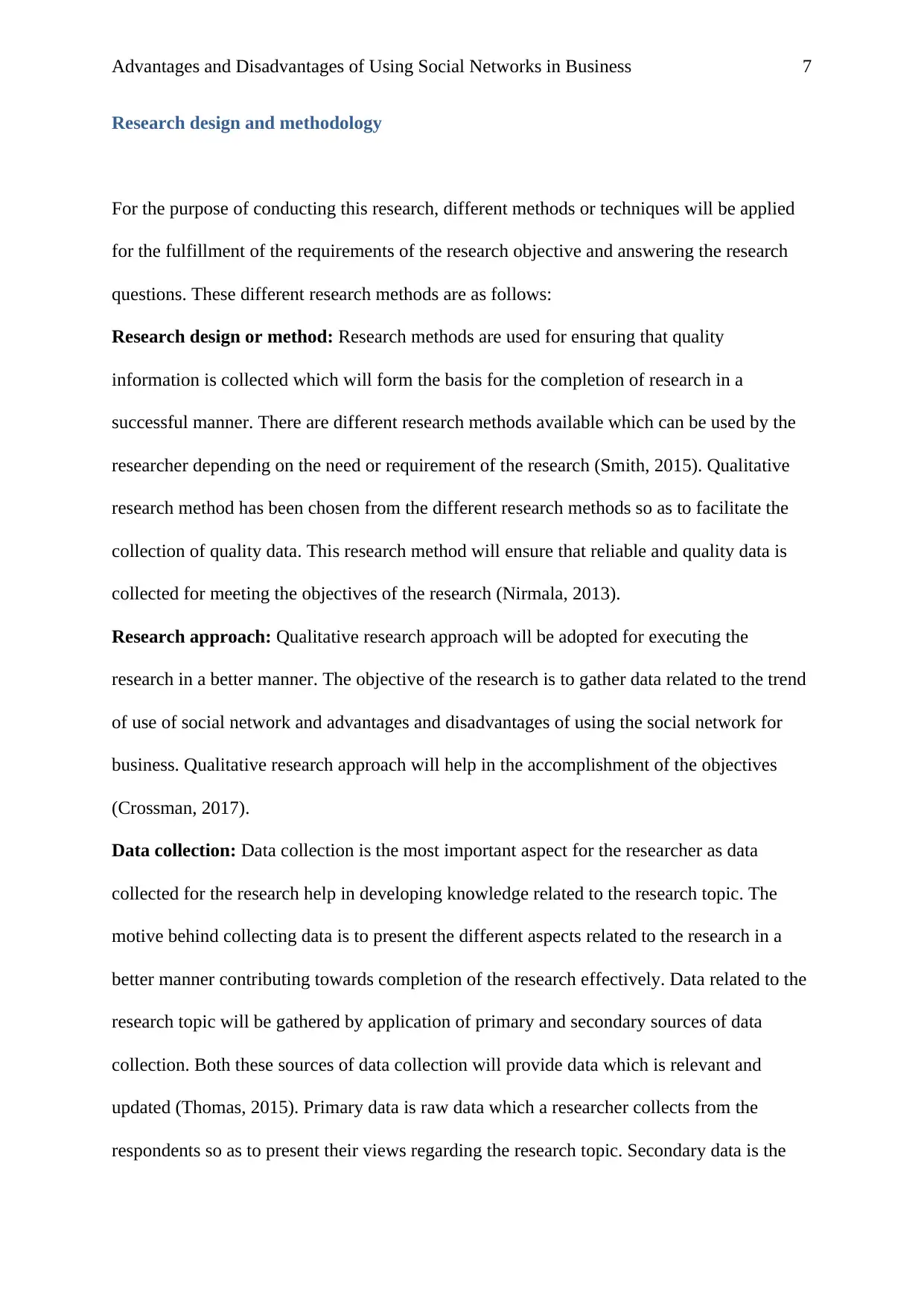
Advantages and Disadvantages of Using Social Networks in Business 7
Research design and methodology
For the purpose of conducting this research, different methods or techniques will be applied
for the fulfillment of the requirements of the research objective and answering the research
questions. These different research methods are as follows:
Research design or method: Research methods are used for ensuring that quality
information is collected which will form the basis for the completion of research in a
successful manner. There are different research methods available which can be used by the
researcher depending on the need or requirement of the research (Smith, 2015). Qualitative
research method has been chosen from the different research methods so as to facilitate the
collection of quality data. This research method will ensure that reliable and quality data is
collected for meeting the objectives of the research (Nirmala, 2013).
Research approach: Qualitative research approach will be adopted for executing the
research in a better manner. The objective of the research is to gather data related to the trend
of use of social network and advantages and disadvantages of using the social network for
business. Qualitative research approach will help in the accomplishment of the objectives
(Crossman, 2017).
Data collection: Data collection is the most important aspect for the researcher as data
collected for the research help in developing knowledge related to the research topic. The
motive behind collecting data is to present the different aspects related to the research in a
better manner contributing towards completion of the research effectively. Data related to the
research topic will be gathered by application of primary and secondary sources of data
collection. Both these sources of data collection will provide data which is relevant and
updated (Thomas, 2015). Primary data is raw data which a researcher collects from the
respondents so as to present their views regarding the research topic. Secondary data is the
Research design and methodology
For the purpose of conducting this research, different methods or techniques will be applied
for the fulfillment of the requirements of the research objective and answering the research
questions. These different research methods are as follows:
Research design or method: Research methods are used for ensuring that quality
information is collected which will form the basis for the completion of research in a
successful manner. There are different research methods available which can be used by the
researcher depending on the need or requirement of the research (Smith, 2015). Qualitative
research method has been chosen from the different research methods so as to facilitate the
collection of quality data. This research method will ensure that reliable and quality data is
collected for meeting the objectives of the research (Nirmala, 2013).
Research approach: Qualitative research approach will be adopted for executing the
research in a better manner. The objective of the research is to gather data related to the trend
of use of social network and advantages and disadvantages of using the social network for
business. Qualitative research approach will help in the accomplishment of the objectives
(Crossman, 2017).
Data collection: Data collection is the most important aspect for the researcher as data
collected for the research help in developing knowledge related to the research topic. The
motive behind collecting data is to present the different aspects related to the research in a
better manner contributing towards completion of the research effectively. Data related to the
research topic will be gathered by application of primary and secondary sources of data
collection. Both these sources of data collection will provide data which is relevant and
updated (Thomas, 2015). Primary data is raw data which a researcher collects from the
respondents so as to present their views regarding the research topic. Secondary data is the
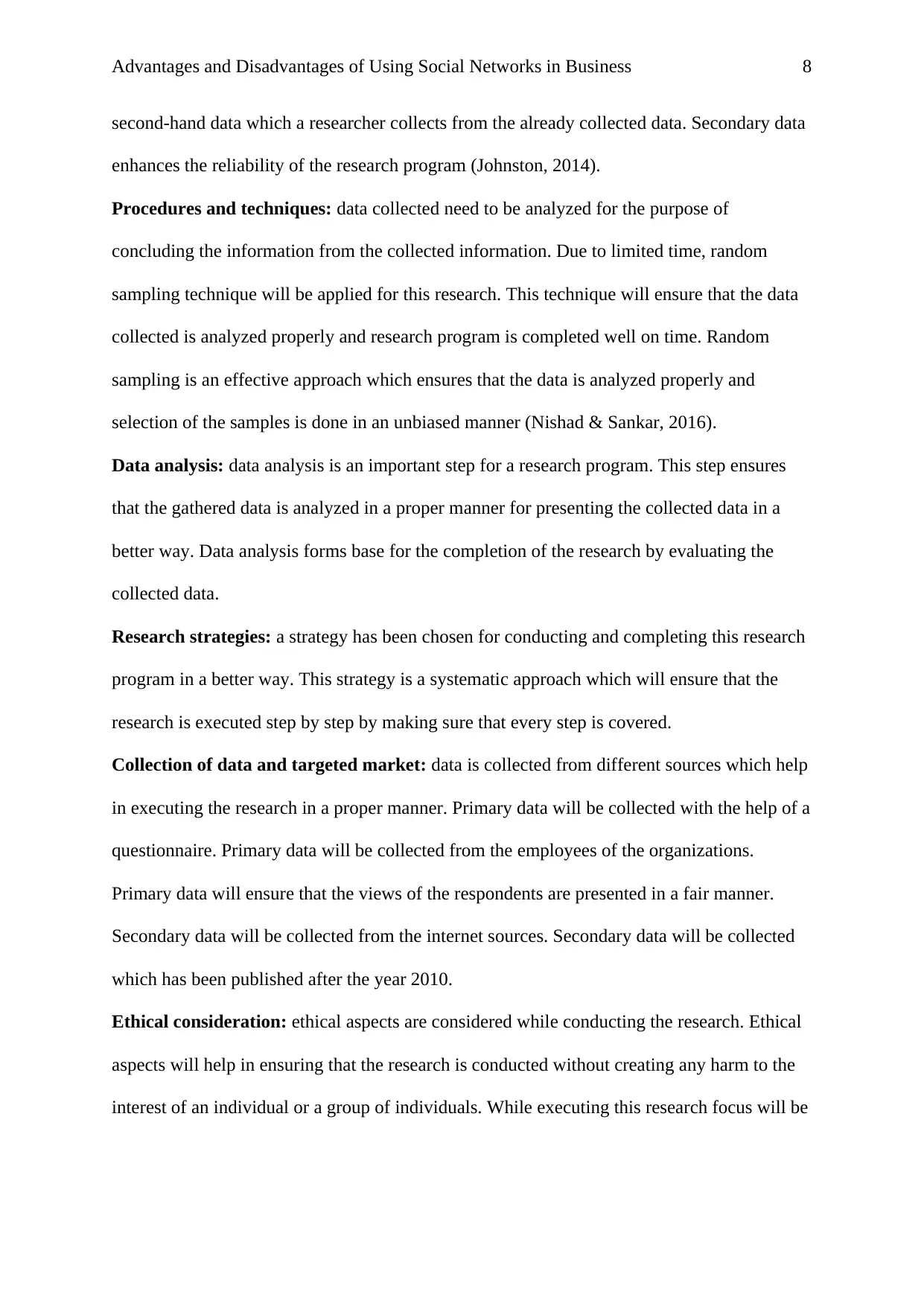
Advantages and Disadvantages of Using Social Networks in Business 8
second-hand data which a researcher collects from the already collected data. Secondary data
enhances the reliability of the research program (Johnston, 2014).
Procedures and techniques: data collected need to be analyzed for the purpose of
concluding the information from the collected information. Due to limited time, random
sampling technique will be applied for this research. This technique will ensure that the data
collected is analyzed properly and research program is completed well on time. Random
sampling is an effective approach which ensures that the data is analyzed properly and
selection of the samples is done in an unbiased manner (Nishad & Sankar, 2016).
Data analysis: data analysis is an important step for a research program. This step ensures
that the gathered data is analyzed in a proper manner for presenting the collected data in a
better way. Data analysis forms base for the completion of the research by evaluating the
collected data.
Research strategies: a strategy has been chosen for conducting and completing this research
program in a better way. This strategy is a systematic approach which will ensure that the
research is executed step by step by making sure that every step is covered.
Collection of data and targeted market: data is collected from different sources which help
in executing the research in a proper manner. Primary data will be collected with the help of a
questionnaire. Primary data will be collected from the employees of the organizations.
Primary data will ensure that the views of the respondents are presented in a fair manner.
Secondary data will be collected from the internet sources. Secondary data will be collected
which has been published after the year 2010.
Ethical consideration: ethical aspects are considered while conducting the research. Ethical
aspects will help in ensuring that the research is conducted without creating any harm to the
interest of an individual or a group of individuals. While executing this research focus will be
second-hand data which a researcher collects from the already collected data. Secondary data
enhances the reliability of the research program (Johnston, 2014).
Procedures and techniques: data collected need to be analyzed for the purpose of
concluding the information from the collected information. Due to limited time, random
sampling technique will be applied for this research. This technique will ensure that the data
collected is analyzed properly and research program is completed well on time. Random
sampling is an effective approach which ensures that the data is analyzed properly and
selection of the samples is done in an unbiased manner (Nishad & Sankar, 2016).
Data analysis: data analysis is an important step for a research program. This step ensures
that the gathered data is analyzed in a proper manner for presenting the collected data in a
better way. Data analysis forms base for the completion of the research by evaluating the
collected data.
Research strategies: a strategy has been chosen for conducting and completing this research
program in a better way. This strategy is a systematic approach which will ensure that the
research is executed step by step by making sure that every step is covered.
Collection of data and targeted market: data is collected from different sources which help
in executing the research in a proper manner. Primary data will be collected with the help of a
questionnaire. Primary data will be collected from the employees of the organizations.
Primary data will ensure that the views of the respondents are presented in a fair manner.
Secondary data will be collected from the internet sources. Secondary data will be collected
which has been published after the year 2010.
Ethical consideration: ethical aspects are considered while conducting the research. Ethical
aspects will help in ensuring that the research is conducted without creating any harm to the
interest of an individual or a group of individuals. While executing this research focus will be
⊘ This is a preview!⊘
Do you want full access?
Subscribe today to unlock all pages.

Trusted by 1+ million students worldwide

Advantages and Disadvantages of Using Social Networks in Business 9
on maintaining confidentiality, performing the activities of the research in an honest manner
and with integrity.
on maintaining confidentiality, performing the activities of the research in an honest manner
and with integrity.
Paraphrase This Document
Need a fresh take? Get an instant paraphrase of this document with our AI Paraphraser

Advantages and Disadvantages of Using Social Networks in Business 10
Research limitations
Limitations affect the research process which can affect the quality of the research. There is a
need to overcome these limitations for conducting the research successfully. Limitations
which can affect the research include shortage of time for conducting the research, limited
access to the data and lack of availability of resources required for executing the research.
Research limitations
Limitations affect the research process which can affect the quality of the research. There is a
need to overcome these limitations for conducting the research successfully. Limitations
which can affect the research include shortage of time for conducting the research, limited
access to the data and lack of availability of resources required for executing the research.
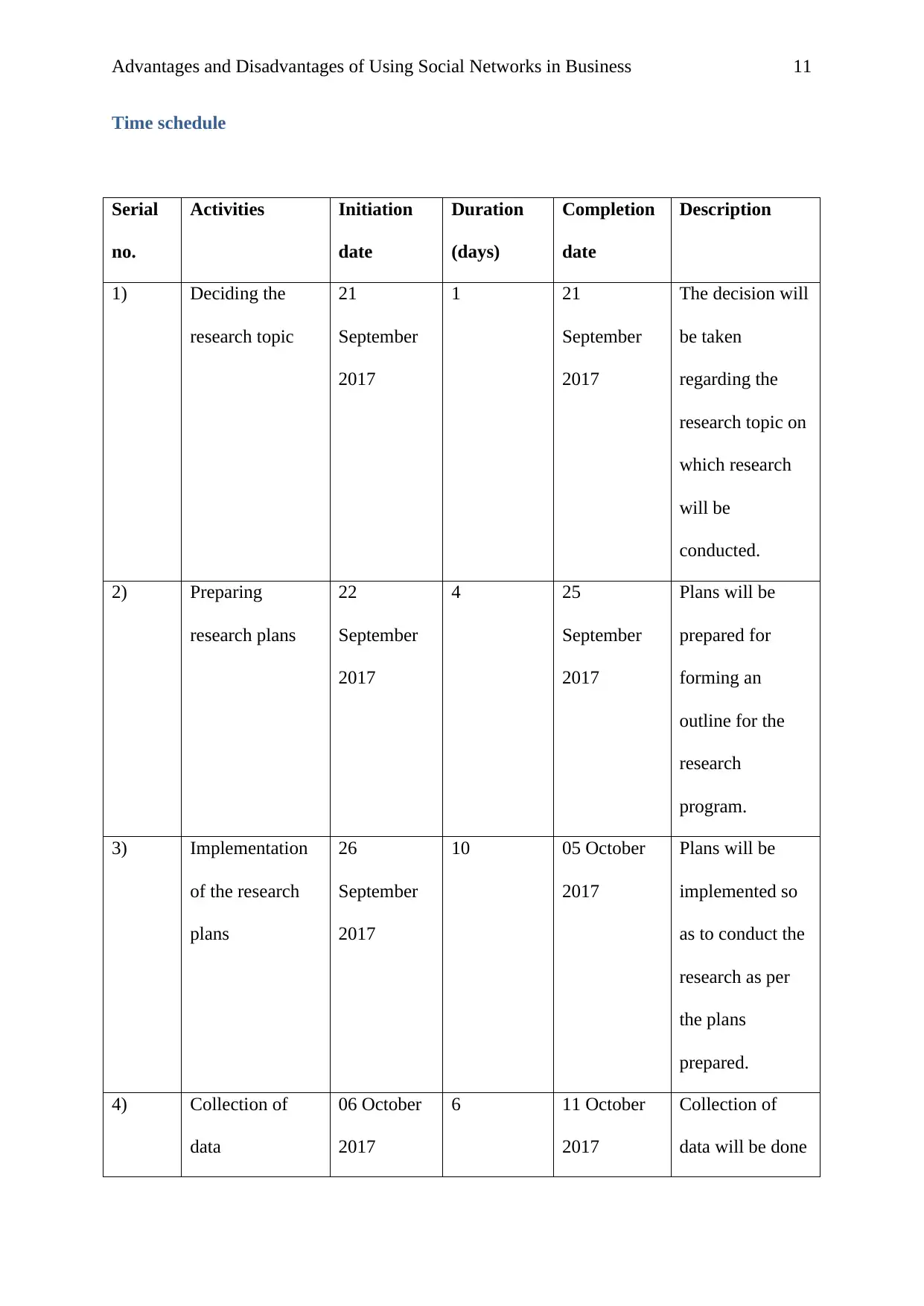
Advantages and Disadvantages of Using Social Networks in Business 11
Time schedule
Serial
no.
Activities Initiation
date
Duration
(days)
Completion
date
Description
1) Deciding the
research topic
21
September
2017
1 21
September
2017
The decision will
be taken
regarding the
research topic on
which research
will be
conducted.
2) Preparing
research plans
22
September
2017
4 25
September
2017
Plans will be
prepared for
forming an
outline for the
research
program.
3) Implementation
of the research
plans
26
September
2017
10 05 October
2017
Plans will be
implemented so
as to conduct the
research as per
the plans
prepared.
4) Collection of
data
06 October
2017
6 11 October
2017
Collection of
data will be done
Time schedule
Serial
no.
Activities Initiation
date
Duration
(days)
Completion
date
Description
1) Deciding the
research topic
21
September
2017
1 21
September
2017
The decision will
be taken
regarding the
research topic on
which research
will be
conducted.
2) Preparing
research plans
22
September
2017
4 25
September
2017
Plans will be
prepared for
forming an
outline for the
research
program.
3) Implementation
of the research
plans
26
September
2017
10 05 October
2017
Plans will be
implemented so
as to conduct the
research as per
the plans
prepared.
4) Collection of
data
06 October
2017
6 11 October
2017
Collection of
data will be done
⊘ This is a preview!⊘
Do you want full access?
Subscribe today to unlock all pages.

Trusted by 1+ million students worldwide
1 out of 17
Related Documents
Your All-in-One AI-Powered Toolkit for Academic Success.
+13062052269
info@desklib.com
Available 24*7 on WhatsApp / Email
![[object Object]](/_next/static/media/star-bottom.7253800d.svg)
Unlock your academic potential
Copyright © 2020–2025 A2Z Services. All Rights Reserved. Developed and managed by ZUCOL.





